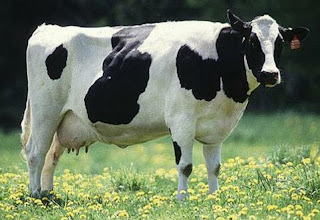Science Fact of the Week 15 - Cows Have Four Stomachs

Cows have four stomachs, or more technically one four-chambered stomach. Cows are ruminants. Most ruminants have a four-chambered stomach, although camels only have three chambers. The first chamber is called the rumen. The next two are the reticulum and the omasum. These first three chambers are believed to be derived from the oesophagus. The last chamber is the abomasum which corresponds to the stomach of other mammals.
The combined four-chambered stomach is big. In medium sized cattle, the rumen by itself can hold between 100 to 300 litres. Ruminants eat fast and store large quantities of grass or foliage in the rumen, where it softens. Many species of tiny protozoans and bacteria live, without oxygen, in the rumen. These little animals and bacteria digest the cellulose in the plant material, thereby releasing the contents of the plant cells for digestion by the cow. Large amounts of saliva get secreted into the rumen to further the digestion.
The action of the various microbes produces various substances, including fatty acids which are absorbed through the rumen wall. In addition, any protein is converted into fatty acids and ammonia; the ammonia is used by the micro-organisms. After the plant material is processed in the rumen, it is later regurgitated. This material is now called cud, and the ruminant chews it again. The additional chewing breaks down the cellulose, which is difficult to digest, even more. The regurgitation and chewing of the cud is called rumination.
The chewed cud goes directly to the other chambers of the stomach (the reticulum, omasum, and abomasum, in that order). Additional digestion, with the aid of various microorganisms, continues in these other chambers. For example, in the omasum, some fatty acids and 60-70 percent of the water are absorbed. In the abomasum gastric juice (containing hydrochloric acid) is secreted, as in an ordinary mammalian stomach, further digesting the food. Also, those micro-organisms that used the ammonia and other nitrogen substances from protein in the rumen, actually get digested by the ruminant in the abomasum and small intestine, thereby providing the cow with protein. Thus can cattle can get a balanced diet from just eating grass or other foliage.

Comments